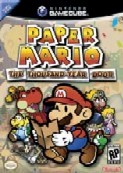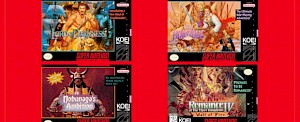Review: Paper Mario: The Thousand-Year Door
Posted 15 Dec 2004 at 07:13 by Wouter
For a long time now there has been a lot of discussion about Mario; Are Nintendo milking the portly plumber too much? Should they invest their creativity in new ideas instead of just making a few new Mario games every year? While a review is not the place to discuss general company strategies, questioning Mario's name on this game is important. Paper Mario isn't a platform game, it's an RPG, so Mario could feel forced onto the game if it's not done good enough. So instead of "How good is Paper Mario?" you get "How good is Paper Mario? And would it have been better without that mustached plumber?" that's two for the price of one!


Rescuing the girl:
Like all Mario RPGs before this one Paper Mario feeds you cliché after cliché in a way that feels surprisingly fresh. The story for instance is nothing really new; Princess Peach gets kidnapped and Mario has to go and rescue her. She's kidnapped for a reason this time though, and while this happens in RPG games all the time, in Paper Mario it feels quite fresh. That's because when Peach is kidnapped it's usually by Bowser, who doesn't seem to have any diabolical plans with her, he just wants to kidnap her. Mario's only clues are a treasure map that Peach sent him, he figures looking for this treasure should also lead him to his dear Princess. Finding this treasure is done in a typical RPG way, Mario has to collect seven star pieces scattered around the land in order to open the Thousand Year Door. The execution is a lot less cliché than it looks like though, not every star piece is hidden in a dungeon and there are many plot twists and interesting characters that keep you from feel like you've seen it all before. Mario also gains a new party member in almost every chapter and all of them are fun characters that help deliver the story in new ways. It also helps that all of the dialogue is filled with great jokes; Paper Mario makes fun of just about everything, but mostly of itself.


Paper-thin:
The GameCube may be a machine that can handle sophisticated 3D graphics, but in Paper Mario characters are as 2D as a piece of paper, even though they move around in a 3D world. This gives the game a unique look, houses unfold when you enter them and characters show how papery they are when they turn around. Because the characters are very simple to calculate for the Cube, Paper Mario can throw literally over a hundred characters at you at the same time, which it does at a regular basis. The paper idea is not only nice to look at, it also affects the gameplay. You really have to examine your surroundings thoroughly because things aren't always what they seem; a wall may just be a piece of paper stuck on an opening, items can be hidden behind scenery and sometimes you can even take a walk in the background of a level. These levels all look very nice by the way. They may be built out of simple 2D paper; every level has a new look complete with its own set pieces, matching enemies and musical tunes to set the mood. So not only does Paper Mario look quite nice, the graphics are also used in a great way to affect the gameplay, what more could you want?
[pagebreak]
The battle system:
Stories and graphics are important, but an RPG lives or dies by its battle system, and Paper Mario certainly has one of the most interesting battle systems you could hope for. It's basically a turnbased battle system, but it's filled with timed button presses and small minigames that determine the effectiveness of your commands. Every attack has a different action command you can pull of to do more damage; do a hammer attack and you have to pull and hold the control stick to the left and release it when a meter onscreen is full, do a jump attack and you can press 'A' exactly as Mario lands his jump to do a double jump.


Magic spells are also present in Paper Mario and they come in two flavors, badge techniques and special moves. Badge techniques are special attacks that use up flower points, you can perform them once you've equipped certain badges and special moves are very powerful moves that use up your star power. Flower points are like magic points in most RPGs, you can replenish them with items or rest, star power is quite a different story. A crowd of spectators is present at every battle in Paper Mario, getting them to cheer for you is the key to filling your star power gauge, the greater the crowd and the more they cheer, the faster your star power fills up. You can even make your attacks more stylish by pressing A at certain times; audiences love this and will reward you with more star power. All these different ways to attack an enemy makes fights really tactical, you really have to think about how you approach an enemy. You can't just hit every enemy with a jump; if you jump on one with a spike on his head you'll only hurt Mario. The crowd even joins the fighting at times; if they're bored they might throw stuff at you or your enemy. Needless to say there's a lot going on in a Paper Mario battle.


Learning is fun:
All these different kinds of moves make the game quite deep; they never make it too complicated though. Paper Mario gives you time to get used to every aspect of the game before it teaches you a new trick. You don't even need to read the manual before you start your first game; every detail is explained to you in a cutscene or by characters you meet. You get the time to practice new features a lot, but this doesn't mean there aren't too many features. Right until the end of the game you'll keep on gaining new abilities, both for Mario and for his growing band of party members. Learning a new move you can use in battle is fun, trying it on different kinds of enemies to see how effective it is rewarding, but learning moves you can use outside battles can be even nicer. The moves you can use outside battles make great use of Mario's paper posture, the first one you learn for instance enables Mario to walk between bars and cracks between walls. Every time you learn one of these moves new areas become reachable in true Zelda tradition, so revisiting locations is a good way of finding secret items.
Final Say:
Paper Mario is everything you need an RPG to be: it's got a nice story, a great battle system, it's filled with puzzles and secrets, and it's even got a sense of humor! It'll also keep you busy for quite a long time, if you want to find every secret and complete every side-quest you'll be busy for at least 50 hours, probably more. It may be filled with clichés, but the way Mario clichés are combined with RPG clichés makes them feel brand new again, so the game wouldn't be half as fun without Mario. There are a few parts of the game that aren't as entertaining as the rest; the game starts rather slow (like most RPGs) and there are a few fetch quests that feel like they're just there to make the game longer, but overall this has to be one of the best, if not the best RPG on the Cube. The balanced learning curve also makes it enjoyable for newcomers to the genre, so don't let all this talk about special moves, star power and flower points scare you off.
N-Europe Final Verdict
A great RPG with great sense of humor.
- Gameplay5
- Playability4
- Visuals4
- Audio4
- Lifespan5
Final Score
9
Pros
Great battle system
Fun story with nice charactersPaper physics
Cons
A few annoying fetch quests
























